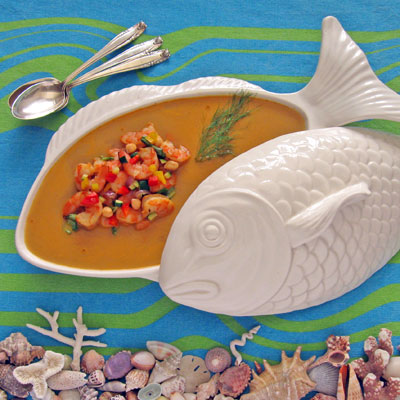
Bouillabaisse Velouté? Boy for a know-it-all there sure is a lot I don’t know.
velouté
[veh-loo-TAY]
One of the five “mother sauces,” velouté is a stock-based white sauce. It can be made from chicken or veal stock or fish fumet thickened with white roux. Enrichments such as egg yolks or cream are sometimes also added. velouté sauce is the base for a number of other sauces and preparations.
I did not know that. I thought a velouté was just fancy French name for a creamy soup.
Rouille
[roo-EE]
Literally French for “rust,” culinarily rouille is a fiery-flavored, rust-colored sauce of hot chiles, garlic, and fresh breadcrumbs and olive oil pounded into a paste and often mixed with fish stock. It’s used as the base in fish stews such as bouillabaisse. But can also be served as a condiment in the classic Provencal soupe de poisson.
I did not know that. Though I have made bouillabaisse plenty of times and could not possibly live with out the stuff in soupe de poisson.

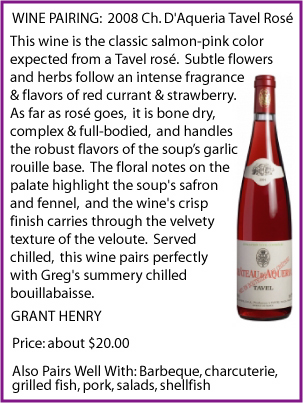 Click For More On Ch. D’Aqueria Tavel RoséSo when I was thumbing through Daniel Boulud’s Cafe Boulud Cookbook looking for soup inspirations. I came across a recipe called Chilled Bouillabaisse Velouté.
Click For More On Ch. D’Aqueria Tavel RoséSo when I was thumbing through Daniel Boulud’s Cafe Boulud Cookbook looking for soup inspirations. I came across a recipe called Chilled Bouillabaisse Velouté.
Which to me meant a creamy, cold summery soup with saffron and seafood. YUM and YES. Were my first two thoughts.
Next I thought I would use this recipe as a jumping off point and make up my own recipe, using what I know about my mother’s bouillabaisse recipe and an immersion blender.
But I did like the unexpected elements of Daniel Boulud’s recipe. He limited the seafood to really good shrimp, and served sauteed summer veggies strewn across the velvety soup. So those ideas I would steal. The rest would be all me.
My recipe was going to be called Velvety Shrimp Soup Provencal with Summer Vegetable Ragout. I figured I’d make it 2 or 3 times and try and get what I was looking for out of it. Then present here at Sup!
I also figured I would get my brother Sip! to do a wine pairing. So I emailed him my plan.
Well, he asked one simple question and threw my whole plan out the window because I did not know the answer!
The question was: “Will your recipe employ a classic rouille base?”
Grant! Don’t do this to me!
So rather than say to my “baby brother” duh, what’s a rouille base? I frantically searched the Internet, and why I was at it I decided to check out velouté too.
Well, when I found out that a velouté was one of the five “mother sauces”, and a rouille was the iconic element in these Provencal fish soups I love so much, I knew I was in over my head. I navigate much better under the notion that naive is the best tool in the box. Once I become aware that I am operating under a handicap I freeze up!
So, and this is hard for me to admit because I rarely do this. But I followed Daniel Boulud’s recipe word for word.
And now that I have made his soup I think the answer to Grant’s question is “no, this soup does not use a rouille base”. It uses all the same flavors, and is thickened with chickpeas instead of flour. So I guess Daniel Boulud was not afraid to take these flavors and make them his own. He was even willing to tweek a mother sauce. Hmmm…
And I further guess that I learned something today. Heck I even learned several somethings. And I get to eat this soup for dinner. All in all not a bad way to spend an afternoon.
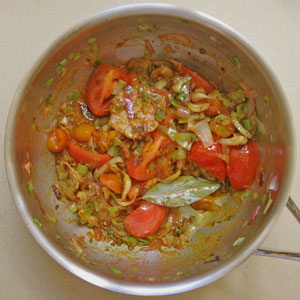 Chilled Bouillabaisse Velouté.
Chilled Bouillabaisse Velouté.
Soup (serves 4)
5 cups water
1/4‑cup extra-virgin olive oil
1 large onion trimmed and thinly sliced
2 stalks celery, thinly sliced
1 medium leek, white and light green parts only, split lengthwise, thinly sliced, washed and dried
1 head of garlic cut crosswise in half
1/4 medium fennel bulb, trimmed and thinly sliced
Salt and white pepper
1 1/2 tablespoons tomato paste
4 medium tomatoes, quartered
1‑pound large shrimp in the shell
1 teaspoon saffron threads
1 sprig thyme
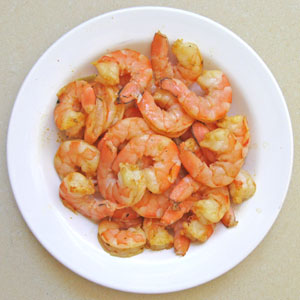 1 bay leaf
1 bay leaf
1/2‑teaspoon fennel seeds
1/2‑teaspoon coriander seeds
1/2‑teaspoon red pepper flakes
2/3 cup cooked or canned chickpeas
Bring the water to boil is a large saucepan, the lower it to a simmer and keep it there.
Pour the olive oil into a large stockpot set over medium heat. When the oil is hot, add the onion, celery, leek, garlic and fennel, season with salt and pepper, and cook, stirring regularly, for 8–10 minutes, or until the vegetables soften but do not color. Add the tomato paste and fresh tomatoes and continue to cook and stir for 4 more minutes. Toss in the shrimp, herbs, and spices and cook stirring, for 2 minutes or until the shrimps turn pink. 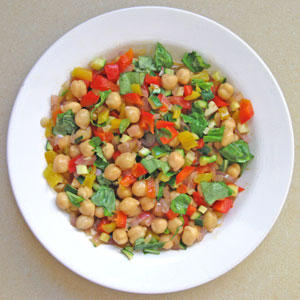 Add the simmering water and cook for 2 minutes more, then, with a slotted spoon, remove the shrimp. Set the shrimp aside for about 10 minutes, so that they’ll be cool enough for you to remove the shells.
Add the simmering water and cook for 2 minutes more, then, with a slotted spoon, remove the shrimp. Set the shrimp aside for about 10 minutes, so that they’ll be cool enough for you to remove the shells.
Shell and de-vein the shrimp, reserving the shells, and refrigerate, covered, until needed. Toss the shells back into the pot and let simmer with the soup for another 30–40 minutes, regularly skimming off the foam and any solids that rise to the surface. When the soup has only 5 minutes left to cook, add the chickpeas. Bring the soup back to a boil, and then pull the pot from the heat.
Pour the soup into a blender and puree until smooth (you may have to work in batches). Push the soup through a fine meshed strainer, so that it is smooth and creamy enough to live up to its name, velouté– it should be thick enough to coat a spoon. If too thick, stir in a little water. Check the seasoning, add salt and white pepper, if needed, and then cover and chill.
Vegetables
3 tablespoons olive oil
1 small onion, peeled, trimmed and cut into 1/4‑inch dice
1/2 red bell pepper, cored, seeded and cut into 1/4‑inch dice
1/2 yellow bell pepper, cored, seeded and cut into 1/4‑inch dice
1 small zucchini scrubbed, trimmed and cut into 1/4‑inch dice
1 small Japanese eggplant trimmed and cut into 1/4‑inch dice
2 cloves garlic, peeled and lightly mashed
Pinch of red pepper flakes
Salt and white pepper
1 tablespoon finely chopped chives
3 leaves basil, coarsely chopped
1/3 cup cooked or canned chick peas
12 Nicoise olives, pitted and quartered
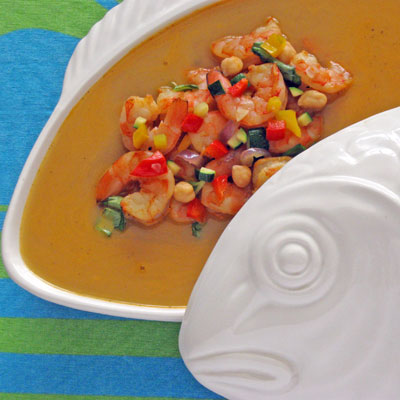 Warm 1 tablespoon of the olive oil in a large saute pan or skillet over medium heat. When the oil is hot, add the onion and peppers and cook, stirring, until the vegetables start to soften but not color, about 3 minutes. Pour in the remaining 2 tablespoons of olive oil and add the zucchini, eggplant, garlic, red pepper flakes, and salt and pepper to taste. Cook and stir for 6 to 8 minutes more, until the vegetables are tender. Turn the vegetables into a serving bowl to cool to room temperature.
Warm 1 tablespoon of the olive oil in a large saute pan or skillet over medium heat. When the oil is hot, add the onion and peppers and cook, stirring, until the vegetables start to soften but not color, about 3 minutes. Pour in the remaining 2 tablespoons of olive oil and add the zucchini, eggplant, garlic, red pepper flakes, and salt and pepper to taste. Cook and stir for 6 to 8 minutes more, until the vegetables are tender. Turn the vegetables into a serving bowl to cool to room temperature.
When the vegetables are cool, remove and discard the garlic. Stir in the chives, half the basil, and the chickpeas. (At this point cover and chill the vegetables a few hours, until needed.)
To Serve
Put the vegetables in a soup tureen, scatter over the shrimp, and sprinkle over the olives. Pour the chilled soup into the tureen and sprinkle the remaining basil over the top. Serve cold.

SERIOUS FUN FOOD
Greg Henry
SippitySup
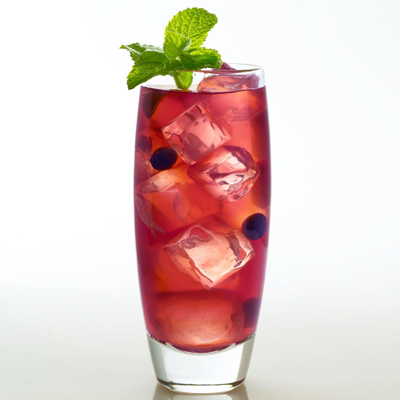
I always loved debate class, but this is really hammer and nail on with all the comments… My problem is when I started blogging I was doing it out of boredom, and wanted to develop something I had inside, like all my recipes…to which I will never remember where they came from…jobs, books, inspiration, but I do give credit where it is due…
I think professional ‘paid’ writers will always resent us blog, because they want to corner a market that cannot be fenced in; for example, like being creative in the kitchen…and music writing…there will always be someone who comes along with a tweaked version of something and make it better…
http://foodbloggercodeofethics.blogspot.com/
are original. Sure, something might be called “pesto” but it’s not really…I just do that to give people some sort of recognition.
I have a hard time reviewing restaurants because I have a feeling like I’m on the same team and you just don’t write something negative about another restaurant. Sure, I might tell a close friend about my experience but I won’t write something down on the internet about it.
Being a food blogger has become a lot more serious since that article in the LA Times came out. I just hope it doesn’t make us all look like a bunch of pirates.
Keep up the good work Greg, I was wondering which one of us would post this article.
Eric
I see where you find the areas of gray, Greg. Like you said, if you take a classic recipe and post your version, then is it really yours? I would say that you give credit where it’s due (if someone inspired you to create the dish, if you modified someone’s recipe, or copied it outright), but if it’s something you actually didn’t refer to a recipe in any form or fashion, then it’s yours. But yes, food bloggers should exercise common sense and courtesy and disclose freebies, sources, etc.
I remembered seeing Arrianna Huffington on Larry King and liked her encouragement of blogging.
A couple of her points, found on this link: http://www.amazon.com/Huffington-Post-Complete-Guide-Blogging/dp/1439105006 (watch the media player)
These ideas were my favorites: blogging should be “a great expression of your passions”, “blog what you love”, and that the goal should be “complete blogging global domination”!! Ha! I love that! I hope my blog does that 🙂 Makes me laugh! Happy Blogging! ‑Chris Ann
We should always give credit where it is due, whether it is online or off. Even giving the impression that something is ours, when it is not, is dishonest.
I have a deep respect for ethics, siting, and integrity. Especially having started my professional life as a photojournalist, and now I’m a hobbyist food blogger.
Not everyone is going to know these things though. Many learn as they go. I think it’s important to realize the difference between journalism and a hobby food blog. If there are mistakes now and then, I think that should be ok.
For those who have use my blog on their blogs I am grateful for the mention, and most bloggers always post where they got the recipe or picture. I see a lot of integrity in the blogging world and am impressed by it.
Great post by the way! This is a fun discussion, and an important one.
Recently, my blog posted a restaurant review of a Washington, DC restaurant called Potenza. It was not a good review for the restaurant. However, it was a fair review of our evening. I am not a professional journalist, or professional cook, but, I think it is fair for me to be able to reflect upon my experience in a restaurant, or for the matter, a book, or a movie. My opinion should count, as should my experience. That’s why I blog, as a form of expression as a writer. As for the code of ethics, I believe you should always do your best to give sources, and give credits, and to be honest. I will include my restaurant review link here: http://lovefeasttable.com/blog/pretend-za-at-potenza-restaurant-review/
I would be curious to know if it “breaks” the code or not. I think it’s an entertaining, fun, and realistic review of how our evening went… when a big deal restaurant didn’t deliver the experience we expected.
Also, do book authors have to have a “code” when they write a book with their opinions? Hmmmm.
Thanks for bring up this topic, it is always good to continue to learn as we go on this journey of blogging. ‑Chris Ann
This has become an issue precisely because many people fail to exercise such common sense as giving credit where it belongs and disclosing any gifts, freebies, etc. Simply because we are not professional journalists does not mean we shouldn’t hold ourselves to high personal standards. I’m both a blogger and a blog reader — as the former, I hope to offer the most original, accurate, fair and respectful work that I would expect as the latter. As a reader, knowing that your meal at the restaurant was comp’d doesn’t mean your review will be rejected outright; it’s simply another variable to use for weighing your opinion. And if someone finds my writing interesting or informative enough to reprint, I hope that they’ll acknowledge my efforts, just as I would for those whose work I have cited.
Thank you for sharing eGullet’s code — we don’t have to sign it in blood but at least read through it and give it consideration.
I’ve seen the brouhaha over this on Serious Eats and a few others and didn’t get it (the fact it was even a debate). I try to follow all of these precepts but not because I signed a code or anything. I think most decent people would try to do these things, just out of common courtesy.
And I totally agree with you on No Quid Pro Quo.…..I hate calamari!
What? You know that was funny. Ok, kind of funny?
No, it was super funny! GREG
There has been much comment in and around this topic of late. Bloggers are (mostly) not journalists but their blogs are public forums. Bloggers opinions may be privately held but if they’re expressed by way of a blog post, they become publicly stated.
For my own part, I guess I would apply what I think of as common-sense rules to what I blog — credit where credit is due for photos or recipes or recipe inspiration, disclosure if I have been offered anything that could be perceived as a freebie. These things just make sense to me. That, and I tend to steer clear of restaurant reviews because that strikes me as a potential minefield.
I’ve participated in this discussion before on other blogs. What I understand to be true is that ingredient lists can not be copywrited or “owned.” It is the presentation of the preparation that is “owned” by the blogger, food writer, video producer, etc.
Take the Peanut Butter and Jelly Sandwich for example. Bread, Peanut Butter and Jelly. How you describe the assembly of the sandwich and variation of ingredients (creamy vs. crunchy) is what creates originality and art.
As “food people” we are constantly inspired by what we consume. It’s how we convey this to others that is what is important. It is this that we as food bloggers own… the photos, the videos, the presentation.
What I would like to see is a discussion of Food Blogger ethics in terms of not being a community of snobs… Mommy Bloggers are far more accepting of others in their community and far less competitive.
I understand how you feel with regards to the recipe-sharing part, although nowadays I don’t cook often.
I may be in the minority here, but I’ve always been more than a little suspect of the claim that someone’s recipe is truly “original,” especially within the realm of food blogs. Most of these recipes are in my opinion, highly derivative. Sure, sometimes the person may not even know that their recipe is already out there, but in most cases I believe they are taking liberty with the definition of “original.” Taking a classic recipe, and changing up the herbs and/or spices involved, and claiming it as your own is just one non-specific example of this. As a classically-trained chef myself, I applaud and actively participate in experimentation in the kitchen, and believe I personally have come up with many interesting and delicious “variations,” but rarely would I ever claim originality. As I’ve mentioned to Greg before, I would say that the only truly original recipes are coming from the minds of the molecular gastronomists and the true master chefs of the world. Maybe it is just a matter of semantics, however.
Blogging is a fairly new phenomenon that I am not sure everyone knows all the rules. I try to come at blogging like writing a paper for a class. Cite sources, give credit where due, spell check and use as much original content as I can. I will always give credit for recipes even if I only use part of the recipe and make it my own. My photography has always been my own and only mine so no credit is given on that end. ( I am not a fan of putting a logo on photos so you won’t ever see that! But that is just personal preference)
Thanks for bringing up an interesing yet very valid topic, I hope your feeling better!
Great food for thought! I struggle with this all the time.
From time to time, I do review places where we eat out. Not every place that we eat at gets a review though. Mostly the ones we like, frequent, and recommend. I think you get in a lot less hot water doing favorable reviews.
I always credit the source whenever I get inspired for a dish. Sometimes I can’t think of a recipe and I’ll search for something that may look appetizing, I usually change it up to fit my tastes, too. I guess there is no one way to answer this becsuae it really is very much a broader spectrum.
There are so many angles to consider here. First, I agree about always trying to credit the source for a recipe or idea or direction taken with a dish. Even if it has been substantially changed, it’s always considerate to include the source/inspiration.
Something I’ve been pondering lately is the difference between hobbyist journalism and the professional variety. In the world of professional journalism, there is supposedly fact checking, source checking, spell checking, etc. To some extent, readers get what they pay for, so when you’re reading a personal blog as opposed to an official news site, you should understand that the information may not be perfectly checked. That being said, ‘real’ news outlets continue to disappoint and personal blogs continue to impress.